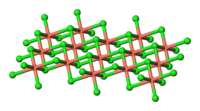Copper(II) chloride
 Anhydrous
|
|
 Anhydrous
|
|
 Dihydrate
|
|
| Names | |
|---|---|
| Other names
Cupric chloride
|
|
| Identifiers | |
|
7447-39-4 10125-13-0 (dihydrate) |
|
| 3D model (Jmol) |
Interactive image Interactive image |
| ChEBI |
CHEBI:49553 |
| ChEMBL |
ChEMBL1200553 |
| ChemSpider |
148374 |
| ECHA InfoCard | 100.028.373 |
| PubChem | 24014 |
| RTECS number | GL7000000 |
| UNII |
P484053J2Y |
|
|
|
|
| Properties | |
| CuCl2 | |
| Molar mass | 134.45 g/mol (anhydrous) 170.48 g/mol (dihydrate) |
| Appearance | yellow-brown solid (anhydrous) blue-green solid (dihydrate) |
| Odor | odorless |
| Density | 3.386 g/cm3 (anhydrous) 2.51 g/cm3 (dihydrate) |
| Melting point | 498 °C (928 °F; 771 K) (anhydrous) 100 °C (dehydration of dihydrate) |
| Boiling point | 993 °C (1,819 °F; 1,266 K) (anhydrous, decomposes) |
| 70.6 g/100 mL (0 °C) 75.7 g/100 mL (25 °C) 107.9 g/100 mL (100 °C) |
|
| Solubility |
methanol: 68 g/100 mL (15 °C)
|
| +1080·10−6 cm3/mol | |
| Structure | |
| distorted CdI2 structure | |
| Octahedral | |
| Hazards | |
| Safety data sheet | Fischer Scientific |
|
EU classification (DSD)
|
Not listed |
| NFPA 704 | |
| Flash point | Non-flammable |
| US health exposure limits (NIOSH): | |
|
PEL (Permissible)
|
TWA 1 mg/m3 (as Cu) |
|
REL (Recommended)
|
TWA 1 mg/m3 (as Cu) |
|
IDLH (Immediate danger)
|
TWA 100 mg/m3 (as Cu) |
| Related compounds | |
|
Other anions
|
Copper(II) fluoride Copper(II) bromide |
|
Other cations
|
Copper(I) chloride Silver chloride Gold(III) chloride |
|
Except where otherwise noted, data are given for materials in their standard state (at 25 °C [77 °F], 100 kPa).
|
|
|
|
|
| Infobox references | |
ethanol:
53 g/100 mL (15 °C)
soluble in acetone
Copper(II) chloride is the chemical compound with the chemical formula CuCl2. This is a light brown solid, which slowly absorbs moisture to form a blue-green dihydrate. The copper(II) chlorides are some of the most common copper(II) compounds, after copper sulfate.
Both the anhydrous and the dihydrate forms occur naturally as the very rare minerals tolbachite and eriochalcite, respectively.
Anhydrous CuCl2 adopts a distorted cadmium iodide structure. In this motif, the copper centers are octahedral. Most copper(II) compounds exhibit distortions from idealized octahedral geometry due to the Jahn-Teller effect, which in this case describes the localization of one d-electron into a molecular orbital that is strongly antibonding with respect to a pair of chloride ligands. In CuCl2·2H2O, the copper again adopts a highly distorted octahedral geometry, the Cu(II) centers being surrounded by two water ligands and four chloride ligands, which bridge asymmetrically to other Cu centers.
Copper(II) chloride is paramagnetic. Of historical interest, CuCl2·2H2O was used in the first electron paramagnetic resonance measurements by Yevgeny Zavoisky in 1944.
Aqueous solution prepared from copper(II) chloride contain a range of copper(II) complexes depending on concentration, temperature, and the presence of additional chloride ions. These species include blue color of [Cu(H2O)6]2+ and yellow or red color of the halide complexes of the formula [CuCl2+x]x−.
Copper(II) hydroxide precipitates upon treating copper(II) chloride solutions with base:
Partial hydrolysis gives copper oxychloride, Cu2Cl(OH)3, a popular fungicide.
...
Wikipedia

